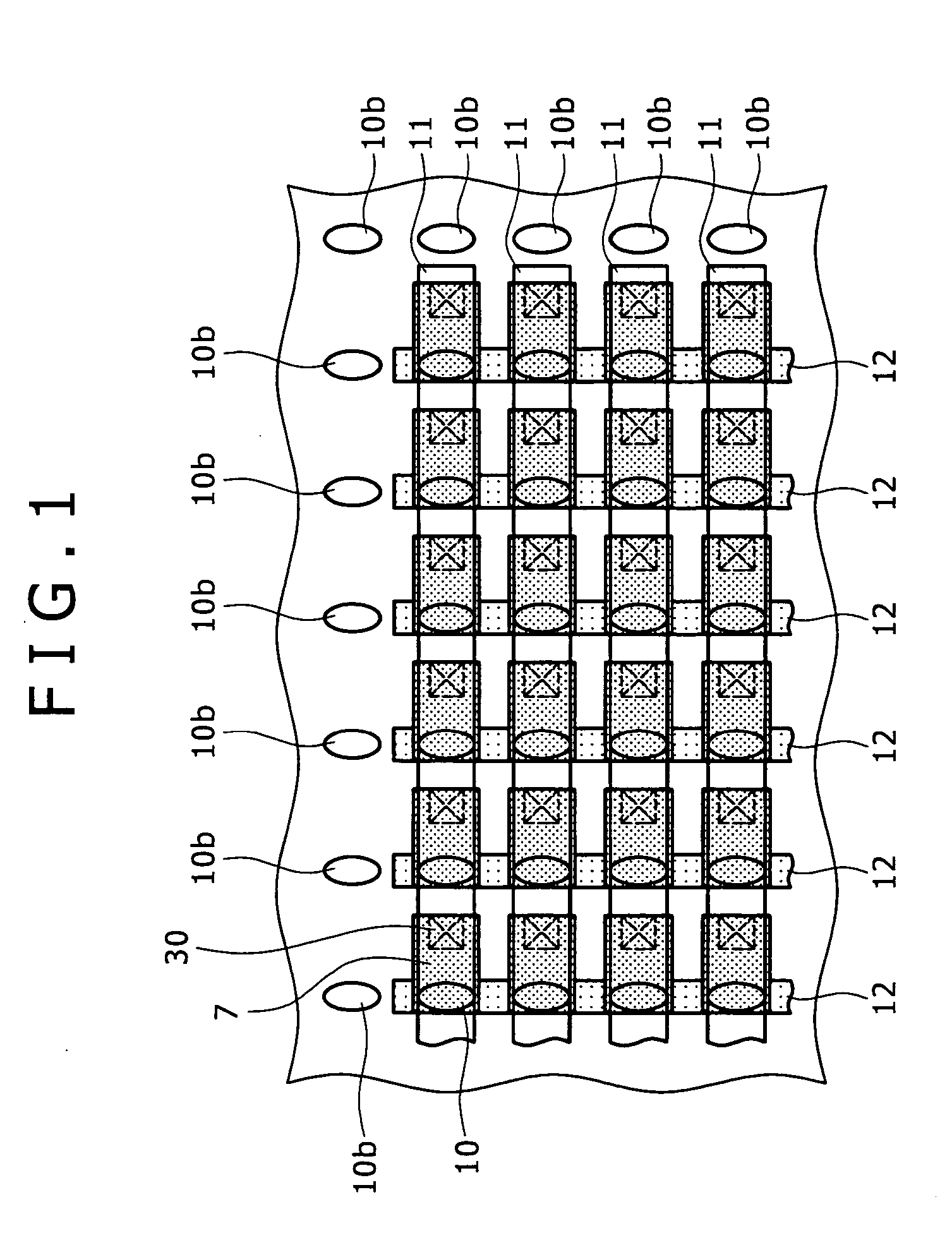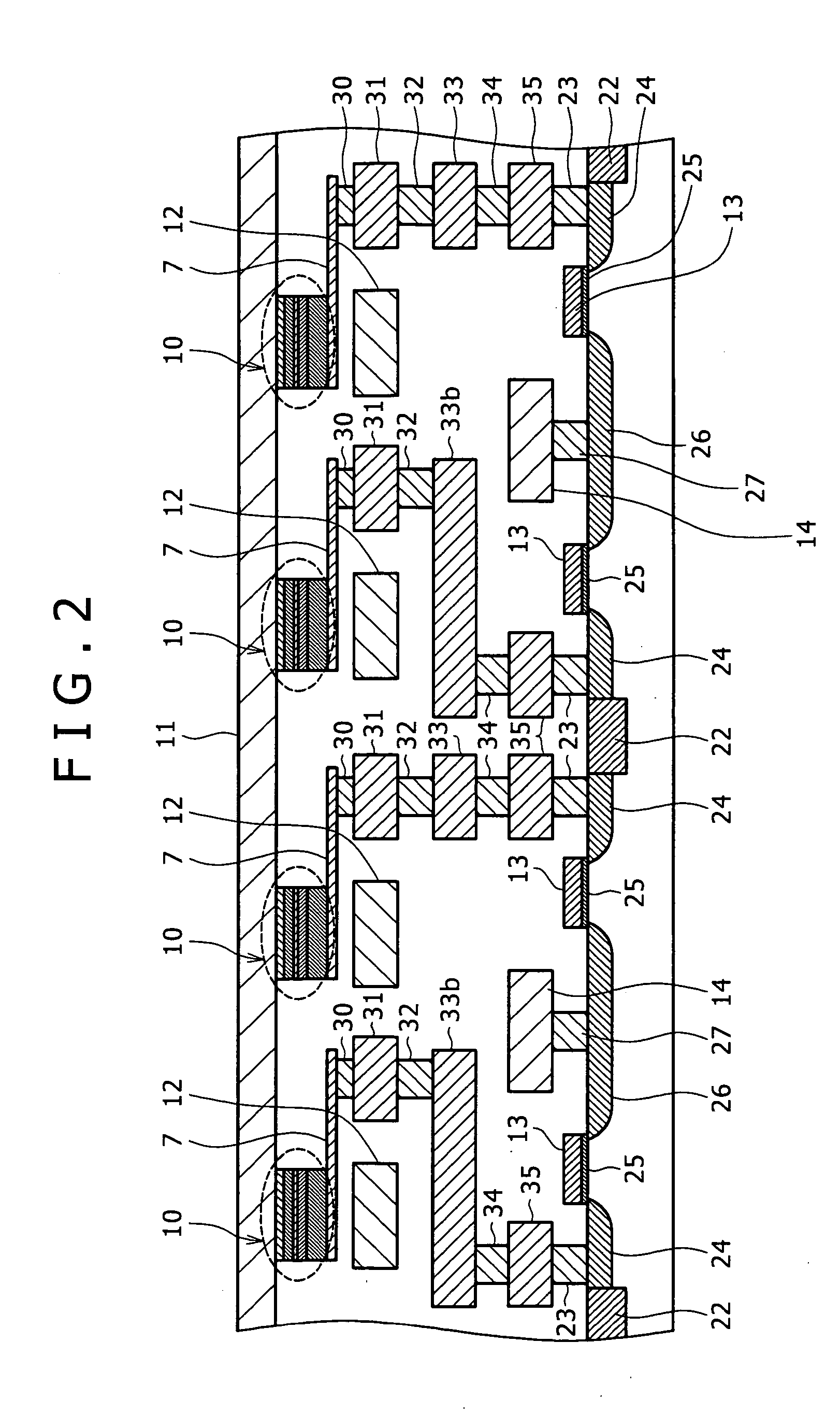Solid-state memory device and method for arrangement of solid-state memory cells
a solid-state memory and memory cell technology, applied in semiconductor devices, digital storage, instruments, etc., can solve problems such as preventing high-capacity memory devices, and achieve the effect of simple structure and rapid writing
- Summary
- Abstract
- Description
- Claims
- Application Information
AI Technical Summary
Benefits of technology
Problems solved by technology
Method used
Image
Examples
embodiment 1
[0104]FIG. 1 is a plan view showing the arrangement of memory cells in the magnetic memory device (MRAM) according to the first embodiment. This magnetic memory device is comparable to MRAM of related art. As in FIG. 15, FIG. 1 does not show, for brevity, the wirings and the transistors for reading (selection) which are formed in the lower layer.
[0105] The MRAM shown in FIG. 1 is identical with the related-art MRAM shown in FIG. 15 in that each memory cell is that of 1T1J type which has one TMR element 10 and one transistor for reading (selection). Each memory cell also includes the lead wiring 7 which extends from the leading electrode 6 of the TMR element 10 and the reading connecting plug 30 which connects the lead wiring 7 to the drain electrode of the transistor for reading (selection). It further includes the bit lines 11 and the writing word lines 12 which are connected to individual memory cells.
[0106] The difference between the two resides in the arrangement of memory cel...
embodiment 2
[0119]FIG. 3 is a plan view showing the arrangement of memory cells in the magnetic memory device (MRAM) according to the second embodiment.
[0120] The MRAM shown in FIG. 3 is identical with the MRAM shown in FIG. 1 according to Embodiment 1 in that each memory cell is that of 1T1J type which has one TMR element 10 and one transistor for reading (selection). Each memory cell also includes the lead wiring 7 which extends from the leading electrode 6 of the TMR element 10 and the reading connecting plug 30 which connects the lead wiring 7 to the drain electrode of the transistor for reading (selection). It further includes the bit lines 11 and the writing word lines 12 which are connected to individual memory cells. As in FIG. 1, FIG. 3 does not show, for brevity, the wirings and the transistors for reading (selection) which are formed in the lower layer.
[0121] This embodiment differs from Embodiment 1 in the way of arrangement. In Embodiment 1, the TMR elements 10 in all the columns...
embodiment 3
[0126]FIG. 4 is a plan view showing the arrangement of memory cells in the magnetic memory device (MRAM) according to this embodiment. The MRAM shown in FIG. 4 is identical with the MRAM shown in FIG. 1 according to Embodiment 1 in that each memory cell is that of 1T1J type which has one TMR element 10 and one transistor for reading (selection). Each memory cell also includes the lead wiring 7 which extends from the leading electrode 6 of the TMR element 10 and the reading connecting plug 30 which connects the lead wiring 7 to the drain electrode of the transistor for reading (selection). It further includes the bit lines 11 and the writing word lines 12 which are connected to individual memory cells. As in FIG. 1, FIG. 4 does not show, for brevity, the wirings and the transistors for reading (selection) which are formed in the lower layer.
[0127] The difference between Embodiment 3 and Embodiment 1 resides in the way of arrangement. The arrangement in Embodiment 1 is such that the ...
PUM
 Login to View More
Login to View More Abstract
Description
Claims
Application Information
 Login to View More
Login to View More - R&D
- Intellectual Property
- Life Sciences
- Materials
- Tech Scout
- Unparalleled Data Quality
- Higher Quality Content
- 60% Fewer Hallucinations
Browse by: Latest US Patents, China's latest patents, Technical Efficacy Thesaurus, Application Domain, Technology Topic, Popular Technical Reports.
© 2025 PatSnap. All rights reserved.Legal|Privacy policy|Modern Slavery Act Transparency Statement|Sitemap|About US| Contact US: help@patsnap.com



